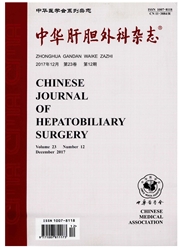

 中文摘要:
中文摘要:
目的探讨肝细胞肝癌(HCC)中血管生成拟态(VM)形成的分子机制。方法收集临床资料和随访资料完整、手术切除并死于HCC的病例99例,对99例HCC进行vEGF、MMP-2、MMP-9免疫组织化学染色,采用Mattern积分法评价三者在99例HCC中的表达,通过比较VM组和无VM组HCC中三者表达水平的差异来研究VM形成的分子机制。结果MMP-2与MMPL9主要以弥漫型或颗粒状在肝癌细胞胞浆内表达,在癌巢的周边伴有组织浸润的部位高表达;VM组比无VM组有更高的MMP-2(t=3.184,P=0.002)与MMP9的表达(Z=2.659,P=0.009);VEGF阳性表达主要位于肝癌细胞胞浆内,毗邻坏死区域的肝癌细胞有较强表达,HCC中VM组与无VM组之间VEGF表达的差异不具有统计学意义(t=1.387,P=0.169)。结论MMP-2、MMP-9在肝癌细胞中高表达,降解并重塑细胞外基质,可能参与VM的形成。
 英文摘要:
英文摘要:
Objective explore the potential molecular mechanism of vasculogenic mimicry (VM) in hepatocellular carcinoma (HCC). Methods Ninety-nine cases of HCC paraffin-embedded samples with complete clinical and pathological data were enrolled into our study. Immunohistochemical staining for MMP-2, MMP-9 and VEGF was performed to explore the mechanism of VM. Their expression was evaluated according to a scoring method reported by Mattern et al. Results MMP-2 and MMP-9 mainly distributed in cytoplasm of the HCC cells. MMP-2 and MMP-9 were observed to have intense expression in the peripheral area of the tumor nests, especially in front of invading areas. VEGF also mainly distributed in cytoplasm of the HCC cells and expressed intensively near the zones of necrosis. The differences of VEGF, MMP-2 and MMP-9 expression between the VM group and the non-VM group were compared. MMP-2 had a significantly higher expression in the VM group than in the non-VM group (t=3. 184, P=0. 002). MMP-9 also had a higher expression in the VM group than the non-VM group (Z=2. 659, P=0. 009). VEGF had no significant difference between them (t=-1. 387, P=0. 169). Conclusion MMP-2 and MMP-9 have increased expression in HCC. They degrade components of the extracellular matrix and are implicated in tissue remodeling and tumor infiltration, which may contribute to the forming of VM.
 同期刊论文项目
同期刊论文项目
 同项目期刊论文
同项目期刊论文
 期刊信息
期刊信息
